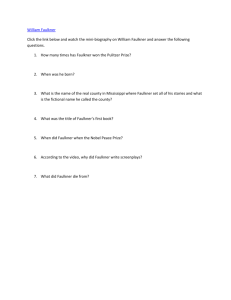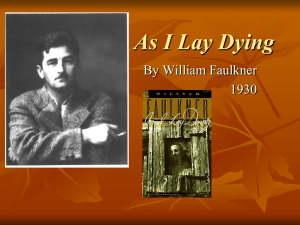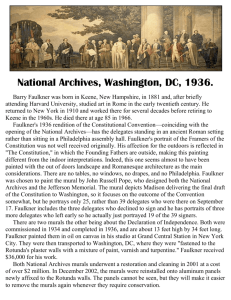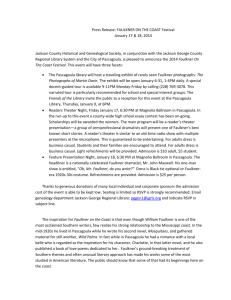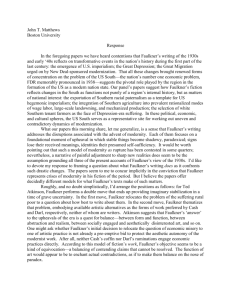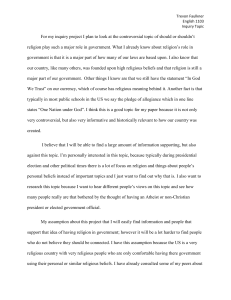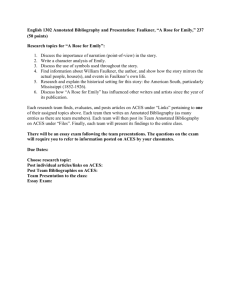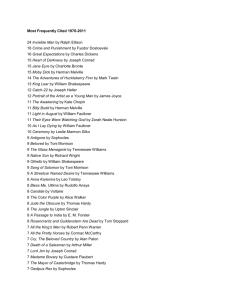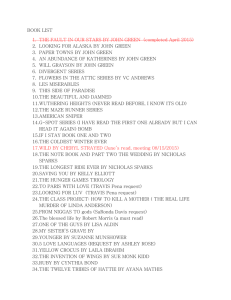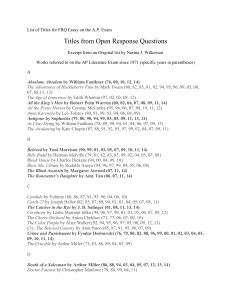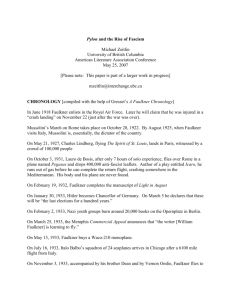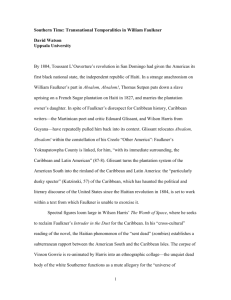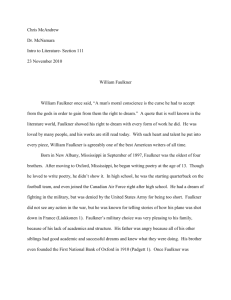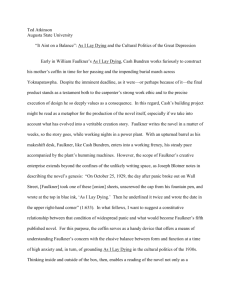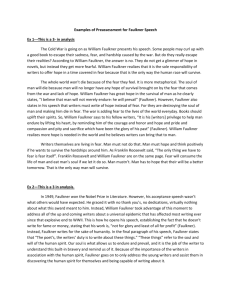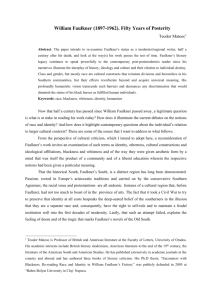William Faulkner (1897
advertisement
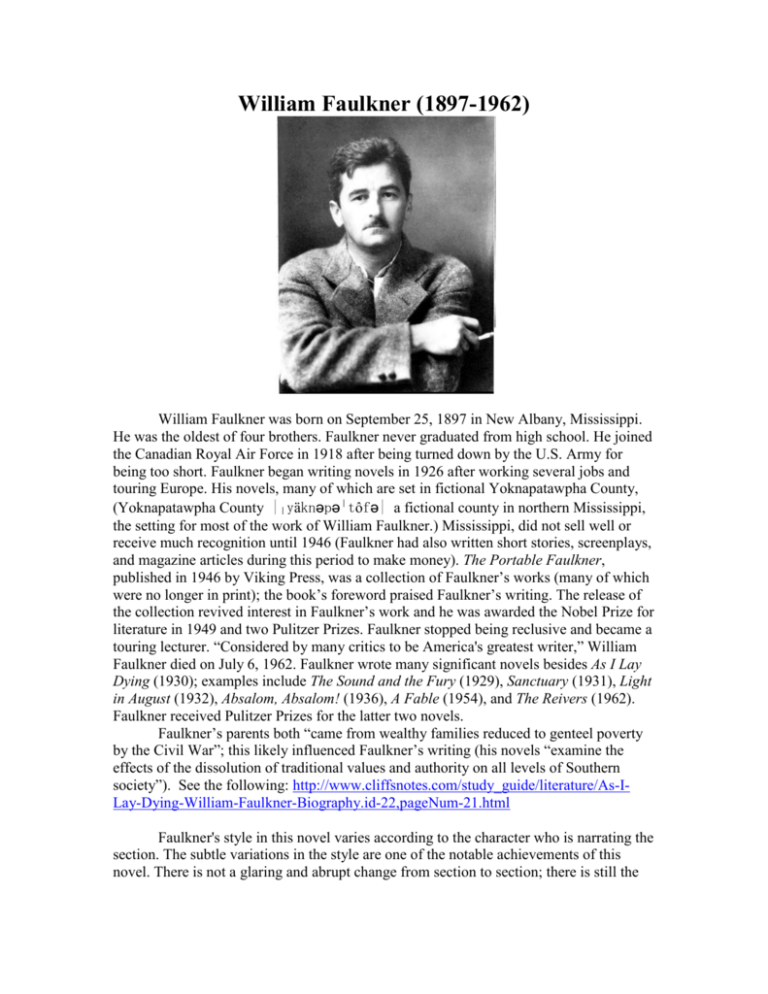
William Faulkner (1897-1962) William Faulkner was born on September 25, 1897 in New Albany, Mississippi. He was the oldest of four brothers. Faulkner never graduated from high school. He joined the Canadian Royal Air Force in 1918 after being turned down by the U.S. Army for being too short. Faulkner began writing novels in 1926 after working several jobs and touring Europe. His novels, many of which are set in fictional Yoknapatawpha County, (Yoknapatawpha County |ˌyäknəpəˈtôfə| a fictional county in northern Mississippi, the setting for most of the work of William Faulkner.) Mississippi, did not sell well or receive much recognition until 1946 (Faulkner had also written short stories, screenplays, and magazine articles during this period to make money). The Portable Faulkner, published in 1946 by Viking Press, was a collection of Faulkner’s works (many of which were no longer in print); the book’s foreword praised Faulkner’s writing. The release of the collection revived interest in Faulkner’s work and he was awarded the Nobel Prize for literature in 1949 and two Pulitzer Prizes. Faulkner stopped being reclusive and became a touring lecturer. “Considered by many critics to be America's greatest writer,” William Faulkner died on July 6, 1962. Faulkner wrote many significant novels besides As I Lay Dying (1930); examples include The Sound and the Fury (1929), Sanctuary (1931), Light in August (1932), Absalom, Absalom! (1936), A Fable (1954), and The Reivers (1962). Faulkner received Pulitzer Prizes for the latter two novels. Faulkner’s parents both “came from wealthy families reduced to genteel poverty by the Civil War”; this likely influenced Faulkner’s writing (his novels “examine the effects of the dissolution of traditional values and authority on all levels of Southern society”). See the following: http://www.cliffsnotes.com/study_guide/literature/As-ILay-Dying-William-Faulkner-Biography.id-22,pageNum-21.html Faulkner's style in this novel varies according to the character who is narrating the section. The subtle variations in the style are one of the notable achievements of this novel. There is not a glaring and abrupt change from section to section; there is still the continuity of the same author behind each section, but there is enough variation to make each narrator distinctly different. The technique that Faulkner uses in many of the sections is called the "stream-ofconsciousness" technique. Prior to the twentieth century, an author would simply tell the reader what one of the characters was thinking. Stream-of-consciousness is a technique whereby the author writes as though he is inside the mind of the characters. Since the ordinary person's mind jumps from one event to another, stream-of-consciousness tries to capture this phenomenon. Thus in many sections, notably in the Vardaman and Darl sections, everything is presented through an apparently unorganized succession of images. Each of the fifty-nine sections in this novel, therefore, represents the inner thought of the character who is narrating the section. This technique reflects the twentieth-century development, research, and interest in the psychology of "free association" and the inner thoughts of people. As a technique, stream-of-consciousness was popularized by James Joyce and Virginia Woolf. But Faulkner's use of this technique is probably the most successful and outstanding. Additional Readings: Biography: http://www.nobelprize.org/nobel_prizes/literature/laureates/1949/faulkner-bio.html Electronic Sources on Works, etc. http://www.mcsr.olemiss.edu/~egjbp/faulkner/faulkner.html Sources: "William Faulkner." Biographies. Answers Corporation, 2006. Answers.com 30 Mar. 2010. http://www.answers.com/topic/william-faulkner "William Faulkner." The Columbia Electronic Encyclopedia, Sixth Edition. Columbia University Press., 2010. Answers.com 30 Mar. 2010. http://www.answers.com/topic/william-faulkner "William Faulkner." The Reader's Companion to American History, Eric Foner and John A. Garraty, Editors, published by. Houghton Mifflin Company, 1991. Answers.com 30 Mar. 2010. http://www.answers.com/topic/william-faulkner "William Faulkner." Who2? Biographies. Who2?, 2010. Answers.com 30 Mar. 2010. http://www.answers.com/topic/william-faulkner

